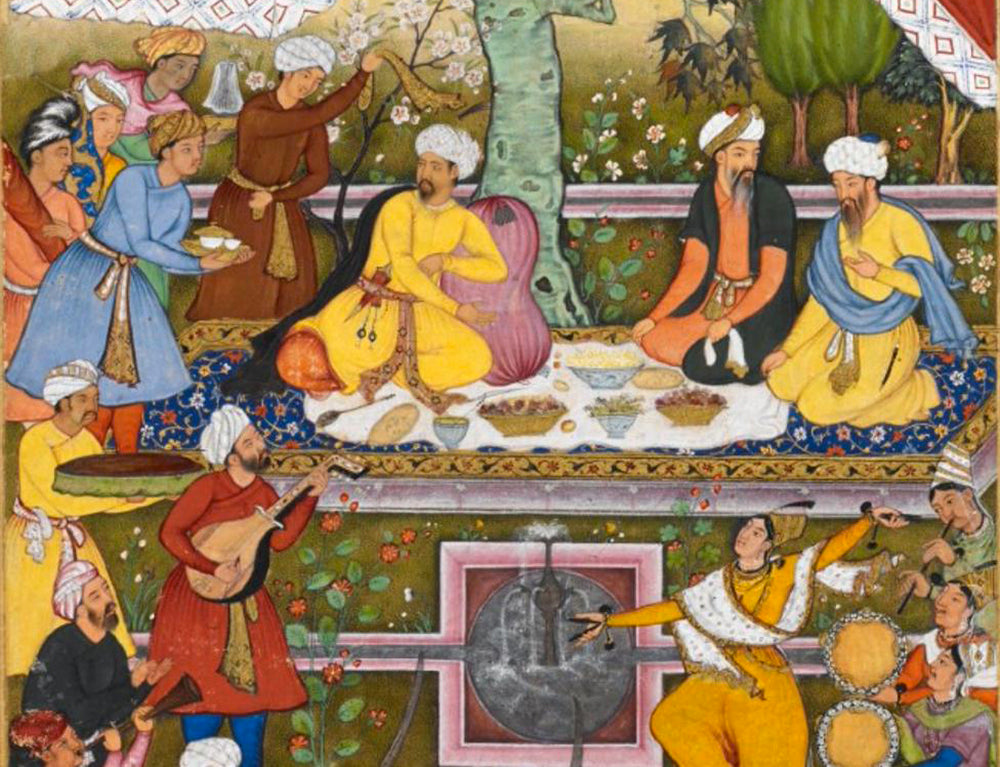Meet The Mughals: The Royal Imprint on Indian Cuisine
By Conchita de Souza

Image: Mughals feasting as the celebrate the Persian New Year (artist unknown)
Did you know that some of India’s most popular and well-known dishes like biryani, korma, pasandas, kebab and kofta, originated from Mughal rulers of India? Mughal cuisine has long been considered as India’s haute cuisine - a befitting title given that it was developed for royalty and required a detailed level of complexity in preparation. Who were these rulers and what kind of influence did their reigns have on Indian food as we know it today? Read on to find out more.
The Mughals
The Mughals were Muslim rulers who were descendants of the Mongols and traced their lineage back to the feared conquerors Gengis Khan and Timur. For over four hundred years (15th - 19th centuries), they ruled over much of the Indian subcontinent which comprised modern-day India, Pakistan, Bangladesh and Afghanistan. Their rule commenced in the north of India and extended as far south as Hyderabad in the state of Telangana. The Mughal reign started with Emperor Babur (1526 - 1530) and ended with Emperor Bahadur Shah Zafar II (1837 - 1857) who only reigned over Delhi by the time he was captured, faced trial and was exiled to Myanmar.
Generally speaking, the Mughal rulers were known for their religious tolerance (perhaps we can exclude Emperor Aurangzeb from here), complex systems of governance, promotion of the arts, architectural extravagance and of course, decadent cuisine. They are also known for their traditions of hospitality, much like the ethos of Atithi Devo Bhava (the guest is God) that underpins Indian hospitality.
The birth of Mughlai Cuisine
Mughlai cuisine involved a fusion of traditional methods of Mughal cooking with the flavours of Indian ingredients (think spices). The marrying of these two aspects created a cuisine that till today, reigns in terms of opulence and complexity.
The Mughal Emperors employed talented chefs of Hindu and Muslim faiths. Both worked harmoniously alongside each other to bring extravagant and decadent dishes, using the best of ingredients, to the royal table. To get a glimpse into the royal kitchens, you can have a read of Emperor Shah Jahan’s cookbook, The Mughal Feast, which was recently translated from Persian to English by author and food historian Salma Yusuf Husain.
Another influence on the cuisine, underrated at times, was that of the marital alliances of the rulers, who would no doubt collaborate closely with the head chefs when it came to meal preparation. One of Emperor Humayan’s wives, and the mother to his successor Akbar, hailed from Persia, and is said to have introduced the lavish use of saffron and dried fruits to the royal kitchens. Emperor Akbar’s wife Johda, a Hindu princess, introduced the lentil dish panchmel dal to the royal cooks. The Emperor himself observed a vegetarian diet three days in a week no doubt to keep on good terms with his Rajput princess (we joke).
Akbar, at his palace in Fatehpur Sikri, had a kitchen superintendent who would oversee the meal preparation (he had a platform at the centre of the kitchen courtyard that enabled him to do this). The superintendent had the important role of tasting the food before it was fed to the Emperor to ensure no foul play was involved.
Characteristics of Mughlai Cuisine
-
Lengthy preparations - meats were marinated in yoghurt and spices well before they were cooked. Stews and curries brewed until the meat dissolved in your mouth at first taste and the list of ingredients to prepare one dish would scare even the bravest of cooks. Let’s just say Mughlai cuisine was not made for the time-poor!
-
Use of tandoor - the traditional oven was heavily relied upon for the preparation of breads and the cooking of meats. Slow-cooked stews and biryanis would be sealed in the tandoor.
-
Meat-based - The Mughal rulers were mostly Muslim and Hindu which explains the absence of pork and beef from its cuisine. Instead, meats like lamb, mutton (goat), chicken and even fish were used as the main protein.
-
Heavy on spices but not always spicy - the fragrance associated with Mughlai food is attributed to the skilful balance of spices both fresh and dried. Mainstream ingredients in Indian food (such as that of turmeric, chilli and garlic) were not employed in the early royal kitchens.
-
Use of dried nuts and fruits - In Mughlai cuisine, dried fruit and nuts are not solely reserved for desserts but are added to rice dishes for flavour contrast as well as texture. Nuts are ground to form the base of certain curries.
- Dairy - Both savoury and sweet Mughal dishes rely heavily on lashings of cream, milk or yoghurt (even all three). Dairy served to mellow the spices.
Our Mughlai Blends
Get your mughlai fix with these spice blends that authentically pay homage to the cuisine of Mughal India. With a little helping hand from our blends, you can prepare these dishes from the comfort (and safety) of your kitchen with all the decadence and finesse that defines Mughlai cuisine but without the stress.
-
Biryani - A rice-based dish synonymous with festivity, celebration and grandeur.

- Malai Kofta - The word kofta refers to any type of ground mince, be it lamb, beef or chicken, that is mixed with fragrant spices, both fresh and dried, and shaped into a ball or submarine-like oval before being cooked.
-
Hyderabadi Kofta - The Nizams (originally Mughals but who broke off and started their own rule) ruled in the southern state of Telengana with Hyderabad as its capital. These sumptuous koftas are sold at roadside stalls and it is hard to limit yourself to just one because they taste that good.

- Navratan Korma - You can expect a creamy texture with aromatic flavours that are punctured by the sweetness of dried fruits, which are traditionally used to garnish this dish.
-
Murgh Korma - This dish is characteristically made creamy with the use of nuts that are fried then ground, as well as the addition of cream and yoghurt.

The legacy of Mughal cuisine has long outlived its rulers to become part of the culinary fabric of Indian gastronomy. In the gullies and lanes of northern India, especially in cities like Delhi and Lucknow, we can see their legacy live on through the local chefs cooking these delights for the common man. The influence of Mughal cuisine has transcended borders and Mughlai menu items are some of the most popular across Indian restaurants around the world and have become synonymous with Indian cuisine.

0 comments